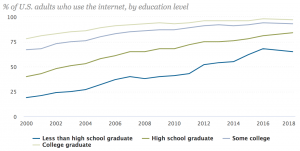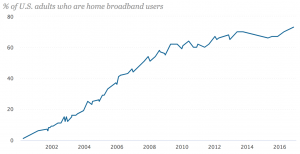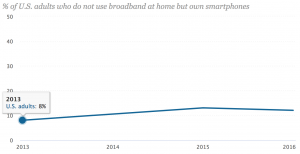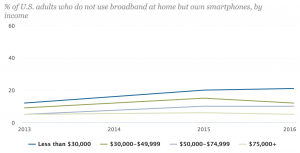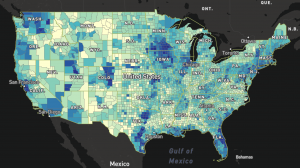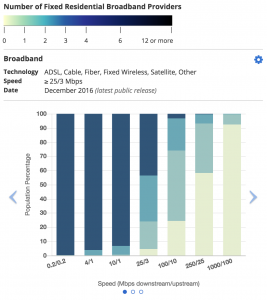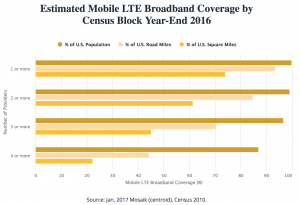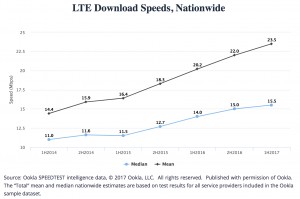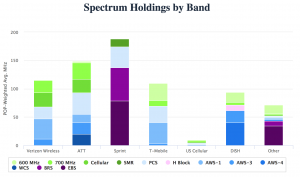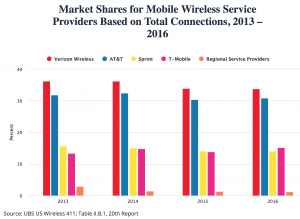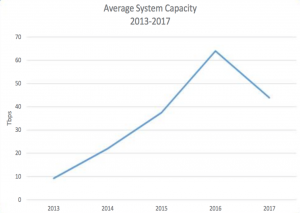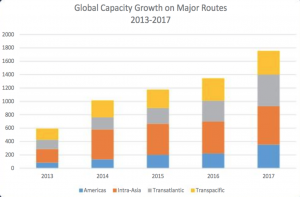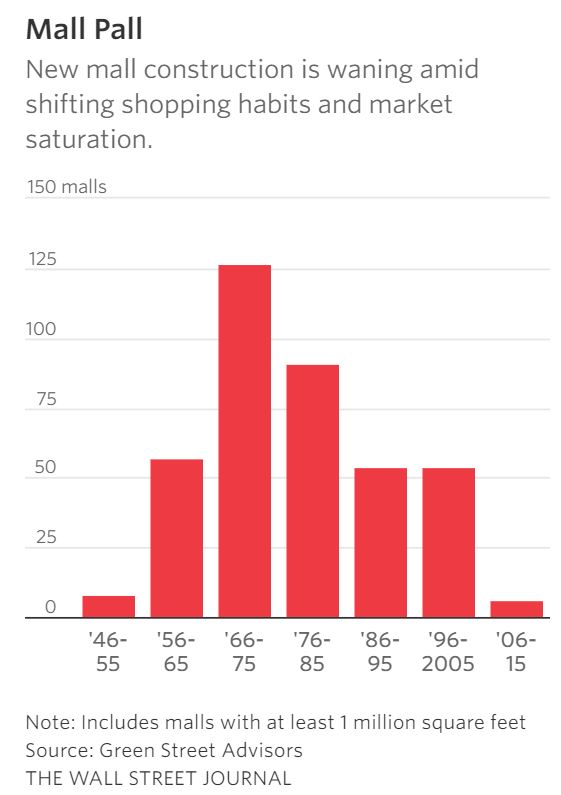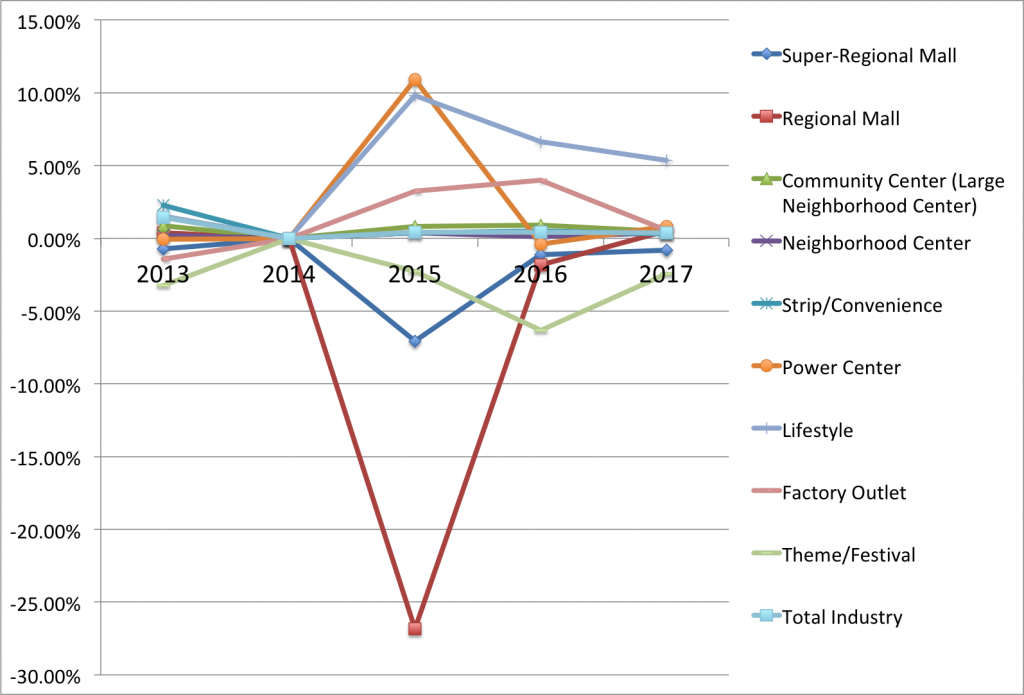Internet Connectivity and Infrastructure
Pew Internet/Broadband Fact Sheet
src:
Pew Research Center, Feb 2018
“Pew Internet/Broadband Fact Sheet”
*
FCC Fixed Broadband Deployment Map
See the source link for an interactive version of the map.
src:
FCC Fixed Broadband Deployment
Accessed April 2018
Note: Discussion of the FCC map and it’s latest version is available here. The latest map is based on 2016 data. FCC does not have an equivalent map for mobile broadband, although it does publish an annual report on mobile wireless competition.
*
20th Mobile Wireless Competition Report Quick Facts
src:
FCC, September 2017
20th Mobile Wireless Competition Report Quick Facts
A couple more interesting bits from the full report…

NOTE: MOU = minutes of voice use
[p.72]
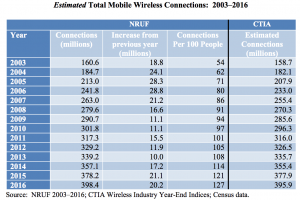
Note: A “connection” is a paid subscription, equivalent to the number of ‘lines’ when discussing landline phone service.
[p.73]
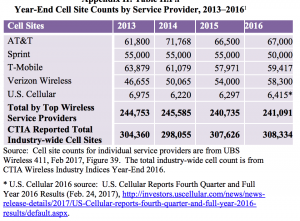
[p.74]
Note: According to CTIA, there has been an approximate 57 percent growth in the number of cell sites over the last ten years (in 1986, there were 1,531 cell sites in service).
The report notes that, according to CTIA, the number of cell sites will significantly increase as the mobile wireless industry densifies and prepares for 5G. Also, because multiple cell sites can be co-located in the same “tower” site, the reported cell sites should not be equated with “towers.” The reported cell sites include repeaters
and other cell-extending devices (e.g., femtocells or distributed antenna systems).
A specialized communications tower industry has developed to provide and manage the
support structures for the cell sites. Today, there are more than 120 tower and DAS operators in the United States, and a majority of towers are now owned or operated by independent companies rather than by mobile wireless service providers.142 Independent tower operators own, operate and lease shared wireless communications and broadcasting towers, manage other tall structure sites (such as rooftops and water towers), and to a lesser extent, own and operate neutral facilities to host small cells and DAS networks for mobile service providers. [p.32]
src:
FCC, Sep 2017
“Implementation of Section 6002(b) of the Omnibus Budget Reconciliation Act of 1993, Annual Report and Analysis of Competitive Market Conditions with Respect to Mobile Wireless, Including Commercial Mobile Services”
*
[In the U.S.] Expected arrival time-frame for 5G roll out with decent coverage and availability in handsets:
early 2020s
(Although 2019 phones will be advertising capacity, even if there’s no network to connect to right away.)
“I believe that eventually consumers will pay for just one broadband connection, fixed and mobile. When I say 50M or more homes, I mean wireless substitution. I think you can draw a parallel with local telephone service and long distance. The long distance business evaporated. Similarly, today’s fixed and mobile broadband services will collapse into one. The cellular operators today are better positioned to take that market.” Peter Rysavy (wireless technologies consultant)
src:
Forbes, Sep 2017
“The Dawn Of 5G: Will Wireless Kill the Broadband Star?”
Ericsson (Nov 2017) has the same prediction for 5G, anticipating coverage for more than 20% of the global population (1 billion) by the end of 2023. First deployments are expected in 2019.
*
Submarine Cable Capacity
src:
Submarine Telecoms Industry Report 2017
[p.17]
*
Network World, Mar 2018
“Submarine cable boom fueled by new tech, soaring demand”
Excerpts:
Between 2013 and 2017, the subsea cable industry has added an average of 32 percent of capacity annually on major submarine cable routes.
SubTel Forum projects global submarine cable capacity will increase up to 143 percent between 2017 to 2022, and it also notes that a construction boom is already underway. Last year, 62,000 miles of submarine cable was added globally. This, after global averages didn’t crack 19,000 miles of added cable between 2013 to 2016.
According to TeleGeography, the international capacity deployed by companies such as Google, Facebook, Microsoft, and Amazon rose 14-fold between 2012 to 2016. … By investing in them, these mega-companies get them built faster. They also get a level of control over construction, maintenance and operation that’s ultimately more economical than becoming a paying customer on a telecom’s cable.
[It’s now cheaper to build systems with greater bandwidth. In 2013, new systems averaged 9 terabits per second (Tbps) — multiple systems planned for 2018 and 2019 will have capacities of 60 Tbsp. Tech advances are also eliminating costly and complex infrastructure layers, such as regen equipment. In addition, new cables can land directly inside multi-tenant data centers, rather than a traditional cable landing station (CLS) on the beach.]
*
Telegeography, Nov 2017
“A Complete List of Content Providers’ Submarine Cable Holdings”
This article lists cables owned or strongly supported by Amazon, Facebook, Google, and Microsoft.
Excerpt:
The amount of capacity deployed by content providers has outpaced all other customers of international bandwidth in recent years. Between 2012 and 2016 the amount of international capacity deployed by companies like Google, Facebook, Microsoft, and Amazon has risen 13-fold to 179 Tbps. (In contrast, international capacity deployed by all other operators only rose threefold, to 272 Tbps).
Content providers prioritize some submarine cable routes more than others in their network deployments. Between 2012 and 2016, content provider demand was the strongest across the Atlantic where capacity rose at a compound annual rate of 66 percent to 42 Tbps.
And as such, the largest content providers have built U.S.-centric network architectures. Their investments on systems directly connecting Europe to Asia are almost non-existent, in comparison. In the Atlantic and Pacific, content providers accounted for over half of total demand in 2016. In contrast, content providers represented only a small share of capacity usage on routes connected to the Middle East and Africa.
Used International Bandwidth by Source, 2002-2016
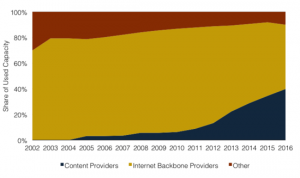
*
Submarine Telecoms Industry Report 2017
Excerpts:
Submarine fiber systems ownership
2013-2017: 61% private, 39% consortium
2018 and beyond: 83% private, 17% consortium
A recent trend towards private ownership has been observed compared to historical trends of primarily consortia ownership. Business cases for smaller systems have been prevalent, and the demand driving these systems has differed from years past. Globe-spanning infrastructure cables that require consortium ownership have fallen out of favor, contributing to this trend shift.
The boom of private ownership will continue to extend well into the future, as more niche and point-to-point systems are implemented. Much of this is driven by intra-regional needs — typically for smaller nations looking to get connected. However, a growing number of systems are being driven by factors not previously seen in the submarine fiber industry.
[p.22]
*
Norway Telecom Trends
The Norwegian Communications Authority prepares a twice annual report of statistics showing developments in electronic communications services, including fixed telephony, mobile telephony and services, broadband and TV transmissions.
See especially Chapter 2, Development Trends, stating on page 11
src:
Norwegian Communications Authority, May 2016
“The Norwegian Electronic Communications Service Market 2015”
Global Mall Development Trends
Ask
Update on mall building rates? US? Globally? Developing world?
Trends in mall development
Results
Global Mall Construction Rates
In 2016, global shopping center completions were up 11.4% over 2015 levels, despite having slowed over the past few years.
However, the pace of development continues to slow, with the number of shopping centers under construction down 22%
The majority of added shopping center space came to market in Asia, but The Americas registered the strongest growth, with completion levels up 43.6%, fueled by construction growth in Mexico.
Src:
CBRE via Malls.com, May 2017
*
In 2016:
17% of retailers planned to open more than 40 stores
67% planned to open no more than 20
Most popular formats for expansion
76% street shops
72% regional shopping malls
45% open air shopping malls
20% transport hubs (airport, railway terminals)
18% outlets
18% retail park
15% concession counters in department stores
8% duty free
src:
CBRE Research, April 2016
“How Active Are Retailers Globally?”
*
Global shopping centre completions started to slow (in 2015) as parts of the global retail market witness the effects of an imbalance between significant supply and demand.
Despite this, there continues to be exceptional levels of construction, particularly in Asia. Globally, 10.7 million sq m of new space opened in 2015 in the 168 cities we surveyed; this is down on 2014, where 12.1 million sq m of space were completed; and a further 41.9 million sq m is under construction, up from 39 million in 2014.
src:
CBRE, April 2016
Global Retail ViewPoint – Shopping Centre Development April 2016
[full report here]
Discussion of the above CBRE report is available here.
*
Global Retail Development Index
Shows where retail investment has been most attractive (ranks top 30 countries). These are the top 10 countries in 2017
India 71.7
growing middle class, rapidly increasing consumer spending, overtakes China
China 70.4
market is maturing, still leading in e-commerce
Malaysia 60.9
good long-term prospects bc of tourists, higher disposable income, govt investments
Turkey 59.8
moved up two places
United Arab Emirates 59.4
most attractive market in the region
Vietnam 56.1
moves ahead, important market for retail expansion with its liberalized investment laws
Morocco 56.1
continues to rise in rankings, govt efforts to attract foreign investment
Indonesia 55.9
continued liberalization and infrastructure investments
Peru 54
outperforms other regional economies, two decades of solid growth
Colombia 53.6
despite lower than expected GDP growth, still attractive for retailers
src:
ATKearney, 2017
The 2017 Global Retail Development Index™
CC’s note: These rankings are available back to 2004. Could aggregate, if this were of interest to KK. (Started to aggregate a couple years’ of data, but stopped bc I wasn’t sure if it was of interest.)
Relig-Shop-Dev-Homes-Extrapolations.xlsx
GRDI tab
European Mall Construction Rates
In 2016, European shopping center construction was down 6% overall compared with 2015. Western Europe saw an increase of 15% in new shopping center completions, but this was outweighed by a 17% decline in the UK, as well as a 17% decline in Central and Eastern Europe (which also dropped 11% in 2015). Further declines are expected in 2017.
src:
Cushman & Wakefield, May 2017
“European Shopping Centers: The Development Story”
[full report behind paywall]
US Mall Construction Rates
U.S. mall development peaked in the 1970s and has steadily declined. Just six large malls were built between 2006 and 2015, compared with 54 during the previous decade, according to Green Street.
src:
Wall Street Journal, Oct 2017
“Big Mall Operator Does the Unthinkable—Builds a Mall”
paywall, these excerpts via Zerohedge
“With Malls In Full Meltdown Mode, GGP Goes All-In With $525MM Connecticut Mega-Mall”
*
Retail Availability Rates, US, 2016
2005 7.4%
2006 8.1%
2007 9.0%
2008 10.8%
2009 12.6%
2010 12.9%
2011 12.9%
2012 12.5%
2013 11.7%
2014 11.0%
2015 10.7%
2016 10.2%
2017p 10.1%
2018p 10.0%
2019p 10.1%
Excerpts:
The oft-reported demise of the retail sector was another topic tackled by the panelists. But they were not ready to sign on to the prevailing attitude that retail is in steep decline. “Store growth continues on a net basis,” Ludgin said.
The forecast found economists equally optimistic about the retail sector. Vacancy rates (see above) are expected to hold steady at about 10 percent for the next two years, while rental rate growth will decline from 2.7 percent to 2.0 percent in 2018—still above historic averages, the economists predict.
Though the panelists agreed that many elements of the retail sector will continue to struggle—in particular, certain suburban malls—others will see an uptick, especially as the link grows between retail and distribution space. Retail space can play a key role in solving the “last mile” issue.
“The store is just a way to deliver goods to people,” Ludgin said. “You may not need the same square footage, but the store is not dead. . . . It’s performing a somewhat different function than in the past.”
Retail space linked to services and entertainment space is still performing well, Conway said. “What we’re not seeing is addition of shop space,” he said. Suburban malls will have to deal with obsolete space, but many retail spaces will evolve, as we “see the convergence of retail and industrial into one,” he said.
Many online retailers, including Amazon, are starting to invest in brick-and-mortar space, Ludgin noted. And discount department stores “remain extremely viable and are still opening stores,” including chains like T.J. Maxx and Nordstrom Rack, which offer a value proposition. “As a nation, we still like department stores, and we still shop in them. It’s just that they are less in regional malls and more in open-air centers,” Ludgin said.
Centers focused on local interests and artisan wares are also performing well, Reagen added. “There is a huge shift in people wanting something different,” she said. “These are centers that will remain viable.”
SRC:
Urbal Land Institute, citing CBRE, April 2017
“ULI Forecast Calls for Moderate Growth for Most U.S. Real Estate Sectors”
*
2015 Summary from research firm CBRE:
Across major U.S. metropolitan areas, completions of new shopping centre space increased in 2015 and the pipeline of new projects grew. In 2015, 13 significant centres were delivered in the cohort of major metropolitan areas, compared to only six in 2014. Lifestyle centres comprised the majority of deliveries, both in terms of the number of centres and their area; the largest of these was the Village at Westfield Topanga (54,812 sq m) in the San Fernando Valley of Los Angeles. The greatest numbers of new shopping centres were delivered in Texas, with three in Houston and two in Fort Worth. [p.6]…
Within the U.S. there are now 15 major projects under construction up from nine in 2014. The most activity remains concentrated in the New York City metropolitan area, fuelled by the massive American Dream at Meadowlands, which is being developed by the owners of the largest mall in the United States – Mall of the Americas in Minnesota; the centre includes an indoor ski slope, among other attractions. Other projects in the city are smaller, but have a very high profile: The World Trade Center shopping centre in downtown Manhattan, operated by Westfield, and The Shops and Restaurants at the Hudson Yards, a huge new mixed use project developed by Related and Oxford on the West side of Manhattan, and City Point, a mixed use development in downtown Brooklyn (Acadia). Houston has four significant projects under construction, totalling 143,943 sq m. The 15 shopping centres under construction are broadly diversified among new lifestyle centres, super-regional and regional malls and power centres. Generally centres in the U.S. are opening with upwards of 90% occupancy rates. [p.10]
src:
CBRE, Q2 2016
“Global Shopping Centre pipeline rises while overall completion levels start to slow”
*
US Shopping Center Rates of Growth, 2013-2017
src:
CC’s calculation of growth based on ICSC data. See OF-charts.xls, “Shopping-Centers” tab.
2017 data:
ICSC, Jan 2017
“U.S. Shopping-Center Classification and Characteristics”
2016 data: 2016 Internet Archive version of above
2015 data: 2015 Internet Archive version
2014 data: 2014 IA version
2013 data: ICSC, 2014 Economic Impact of Shopping Centers
2012 data: ICSC, 2013 Economic Impact of Shopping Centers
Definitions
GLA: gross leasable area
square footage and industry share data below refer to January 2017
Super-Regional Mall
Similar in concept to regional malls, but offering more variety and assortment.
Avg size: 1,255,382 sq ft
% Share of Industry GLA: 10.2%
Regional Mall
General merchandise or fashion-oriented offerings. Typically, enclosed with inward-facing stores connected by a common walkway. Parking surrounds the outside perimeter.
Avg size: 589,659 sq ft
% Share of Industry GLA: 4.7% (Jan 2017)
Community Center (“Large Neighborhood Center”)
General merchandise or convenience- oriented offerings. Wider range of apparel and other soft goods offerings than neighborhood centers. The center is usually configured in a straight line as a strip, or may be laid out in an L or U shape, depending on the site and design.
Avg size: 197,509 sq ft
% Share of Industry GLA: 25.4%
Neighborhood Center
Convenience oriented.
Avg size: 71,827 sq ft
% Share of Industry GLA: 30.8%
Strip/Convenience
Attached row of stores or service outlets managed as a coherent retail entity, with on-site parking usually located in front of the stores. Open canopies may connect the store fronts, but a strip center does not have enclosed walkways linking the stores. A strip center may be configured in a straight line, or have an “L” or “U” shape. A convenience center is among the smallest of the centers, whose tenants provide a narrow mix of goods and personal services to a very limited trade area.
Avg size: 13,218 sq ft
% Share of Industry GLA: 12.0%
Power Center
Category-dominant anchors, including discount department stores, off-price stores, wholesale clubs, with only a few small tenants.
Avg size: 438,626 sq ft
% Share of Industry GLA: 13.0%
Lifestyle
Upscale national-chain specialty stores with dining and entertainment in an outdoor setting.
Avg size: 335,852 sq ft
% Share of Industry GLA: 2.2%
Factory Outlet
Manufacturers’ and retailers’ outlet stores selling brandname goods at a discount.
Avg size: 238,060 sq ft
% Share of Industry GLA: 1.2%
Theme/Festival
Leisure, tourist, retail and service-oriented offerings with entertainment as a unifying theme. Often located in urban areas, they may be adapted from older–sometimes historic–buildings and can be part of a mixed-use project.
Avg size: 147,791 sq ft
% Share of Industry GLA: 0.3%
Airport Retail
Consolidation of retail stores located within a commercial
airport
Avg size: 249,240
% Share of Industry GLA: 0.2%
src:
ICSC (International Council of Shopping Centers), January 2017
“U.S. Shopping-Center Classification and Characteristics”
***
Trends in Chinese Mall Offerings
Wall Street Journal, Jan 2017
“China Has Too Many Shopping Malls”
CC’s summary:
In 2015, 3.7 million square meters of shopping space was under construction in Chongqing — more than anywhere else in the world (and 10x the retail construction in New York). It’s also a much greater shopping stock than what’s found in China’s four first-tier cities (eg: Beijing, Shanghai) — more than 2 square meters per urban consumer, compared with 0.5sq.m in the first-tier cities. This is a problem because new demand has not been as strong as anticipated (as shoppers leapfrog stores and go directly online). The retail vacancy rate has been rising in many Chinese cities. Some department stores are reporting sharp losses, with some closing in the past year. Some retail developers are including entertainment (hotels, aquariums, sports hubs with rock-climbing, ziplines, indoor surfing, ski slopes) as well as shopping in hopes of staying ahead.
*
Financial Times, November 2017
“China’s high street finds growth alongside ecommerce”
Excerpts:
[Chinese] ]Mall operators have responded to the ecommerce onslaught by reducing space devoted to retail and increasing allocations for restaurants, cinemas and outlets offering extracurricular classes for children. Electronics retailers have added in-store experiences and reallocated floorspace for ecommerce distribution.
In 2016, Shanghai’s Joy City mall installed a gigantic Ferris wheel on its top floor to attract customers.
Gome, an electronics store which is Chinas second largest brick-and-mortar retailer by sales, has added experience-enhancing elements in stores, such as virtual reality zones. It’s offline sales grew 10.5% in the first half of the year.
*
KK: HERE IS A BIG RESEARCH REPORT ON WHAT’S NEW IN CHINESE RETAIL. YOU MIGHT LIKE TO SKIM. THINGS THAT CAUGHT MY EYE:
“NEW RETAIL”
buzz phrase in China’s retail sector, refers to retailers with large physical stores reinventing and transforming their business models and formats. Leveraging Internet, VR, AR etc to offer experience- and lifestyle-driven opportunities.
“CEWEBRITY ECONOMY”
Cewebrities are people who become famous on the Internet. Leveraging the power of their fans and social media, many cewebrities, especially fashion cewebrities, have set up online stores to sell fashion items. Some have even launched their own brands.
RURAL E-COMMERCE
The rural online retail market has become a new growth engine with the near saturation of the urban online market. Rural consumers prefer shopping online because of the less developed retail infrastructure in rural areas. … Recognizing the ample growth potential of the rural e-commerce market, increasing numbers of leading retailers and e-commerce players have adopted various “going rural” strategies. For instance, Alibaba has introduced a partnership program in rural areas. Some 20,000 partners were recruited to teach and help rural residents buy online. At the same time, JD.com has made substantial investment in rural areas to expand “last-mile” delivery capabilities; for example, it has tested drone delivery services in some remote rural areas
src:
Fung Business Intelligence, March 2017
“Spotlight on China Retail”




